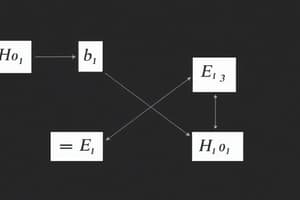Podcast
Questions and Answers
What is the logical sentence represented by p v q?
What is the logical sentence represented by p v q?
- if p then q
- p or q (correct)
- p and q
- negative of p
What is the negation of p denoted by?
What is the negation of p denoted by?
- p → q
- ¬p (correct)
- p v q
- p ⊝ q
What is the logical operation represented by p → q?
What is the logical operation represented by p → q?
- p or q
- if p then q (correct)
- p and q
- negative of p
The AND operation is denoted by the symbol v.
The AND operation is denoted by the symbol v.
What is the biconditional of p and q denoted by?
What is the biconditional of p and q denoted by?
In propositional logic, the set Z is defined as which elements?
In propositional logic, the set Z is defined as which elements?
In propositional logic, the operators used are ¬, ∧, and ___
In propositional logic, the operators used are ¬, ∧, and ___
What is the simplification of (x̅ + y)(y̅ + x)?
What is the simplification of (x̅ + y)(y̅ + x)?
Match the following logical operations with their symbols:
Match the following logical operations with their symbols:
If x is the condition and y is the statement, what is the logical operation for 'IF condition THEN statement'?
If x is the condition and y is the statement, what is the logical operation for 'IF condition THEN statement'?
What is the digital logical circuit that performs the computation for the combination of inputs x1, x2, and x3?
What is the digital logical circuit that performs the computation for the combination of inputs x1, x2, and x3?
Flashcards are hidden until you start studying
Study Notes
Propositional Logic and Digital Logic Circuits
- Propositional logic involves two truth values: true (T) and false (F).
- Key operators in propositional logic include:
- Disjunction (v): ( p \lor q ) (p or q)
- Conjunction (∧): ( p \land q ) (p and q)
- Negation (¬): ( \neg p ) (not p)
- Implication (→): ( p \rightarrow q ) (if p then q)
- Biconditional (↔): ( p \leftrightarrow q ) (p if and only if q)
Mathematical Systems
- Variables ( p, q ) are elements of the set ( Z = {T, F} ).
- Using binary values, the system can be represented as ( Z = {1, 0} ) with binary operators:
- AND: ( \cdot )
- OR: ( + )
- NOT: ( \neg )
Truth Tables
- Truth tables illustrate the outputs for logic gates:
- AND Gate:
- Outputs 1 only if both inputs are 1.
- OR Gate:
- Outputs 1 if at least one input is 1.
- NOT Gate:
- Inverts the input value.
- AND Gate:
Inference Rules
- Fundamental laws govern simplifying digital logic circuits, such as:
- Law of Excluded Middle: A statement is either true or false.
- Law of Non-Contradiction: No statement can be both true and false.
Logical Circuit Formulation
- The implication ( IF , condition , THEN , statement ) can be expressed as:
- ( x \rightarrow y = \neg x \lor y = (x̅ + y) )
Biconditional Design
- A logical circuit for biconditional ( p \leftrightarrow q ) can be formulated as:
- ( (x \rightarrow y) \land (y \rightarrow x) )
- This can be rewritten using logical operators as ( ( \neg x \lor y) \land ( \neg y \lor x) ).
Circuit Simplification Example
- A computation example with variables ( x_1, x_2, x_3 ) simplifies to:
- ( Y = x_1 \cdot x_2 \cdot x_3 + x_1 \cdot x_2 \cdot x_3' + x_1' \cdot x_2' \cdot x_3 + x_1' \cdot x_2' \cdot x_3' )
Final Simplified Circuit
- Following distribution and simplification using inference rules:
- ( Y = x_1 \cdot x_2 + x_2 \cdot x_3 \rightarrow Y = x_1 + x_2)(x_2 + x_2 \cdot x_3) \rightarrow Y = x_1 + x_2 + x_3 )
Exclusive-NOR Logic
- The exclusive-NOR operation is denoted by ( p \downarrow q ), representing equivalence in logical terms.
General Observations
- Rules of inference and logical operations can be applied to optimize and simplify digital logic circuit designs effectively.
Studying That Suits You
Use AI to generate personalized quizzes and flashcards to suit your learning preferences.




